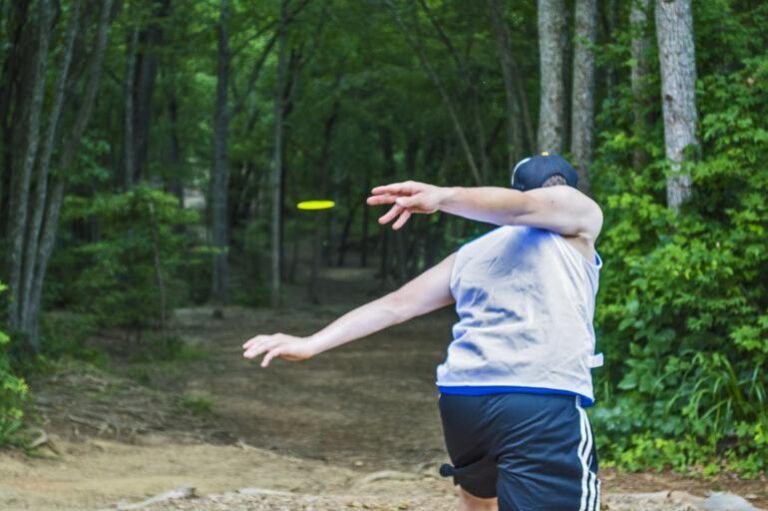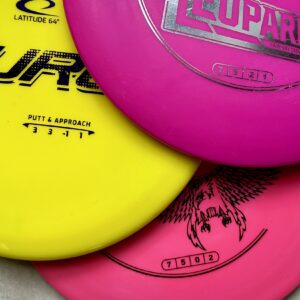Seen a disc veer like a homing pigeon, then nosedive like it spotted lunch? The riddle is solved by disc golf flight ratings. Those four little numbers, speed, glide, turn, fade, predict what your throw will do before you even reach the tee. Learn them once, and your discs start flying the lines you imagine.

Disc Golf Flight Ratings Explained
Think of the four ratings as a tiny instruction manual stamped on the disc.
- Speed is how fast a disc wants to be thrown to fly as designed. High speed ratings suit powerful throws. Lower speed discs are easier to control and go surprisingly far for most players.
- Glide is hang time. More glide means longer carry. Less glide means a more direct, wind resistant flight.
- Turn is the early movement at high speed. Negative turn means it drifts right on a RHBH throw. Positive turn means it resists that drift.
- Fade is the late finish as the disc slows. Higher fade means a stronger left finish for RHBH.
These four act together to shape the flight path. Speed and glide set the middle of the flight. Turn and fade bookend it.
How to read disc golf flight ratings
Manufacturers print disc golf flight numbers like this, Speed | Glide | Turn | Fade. For example, 9 | 5 | -2 | 2.
- 9 is the disc golf speed rating. Most newer players get better distance with 6 to 9 rather than racing to 13.
- 5 is the disc golf glide rating. More glide carries farther, helpful for long distance throws at modest power.
- -2 is the disc golf turn rating. Negative numbers drift right on RHBH, useful for a turnover shot or hyzer flip.
- 2 is the disc golf fade rating. Expect a mild fade finish back left at the end.
Disc Golf Flight Ratings Explained means you can pick shots, not pray. Below is understanding disc flight ratings in a bit more detail.
Why slower discs can go farther for you
Counterintuitive but true. If your power is below what a high speed driver expects, it never wakes up. A fairway with speed 7 to 9 will often outfly a 12 for many players. It needs less launch speed to turn, ride its glide, then finish predictably. That means cleaner lines, better accuracy, and more parked approaches.
Overstable and understable in plain English
- Overstable discs fight rightward drift and finish harder left on RHBH. Great into a headwind and for reliable hyzer shots.
- Understable discs drift right on RHBH when thrown fast. Great for anhyzer lines, hyzer flips, rollers, and tailwinds.
What does negative turn mean in disc golf
Negative turn means the disc wants to move right early on a RHBH throw. That makes shaping lines easier at modest power. Use it for:
- Anhyzer shots that hold the turn.
- Hyzer flip throws that pop up to flat, ride straight, then finish gently.
- Easy turnover shot lines that never fight back left.
- Tailwinds where the disc keeps gliding rather than dumping.
Understanding disc golf glide rating
Glide is free distance when you have clean form. High glide keeps the disc afloat and can turn a 60 percent throw into a useful approach. Low glide pierces the air and resists lift, helpful in gusts or tight fairways where you want the disc to sit down.
What gives a disc more glide
- Disc design matters. Wider, flatter tops often add glide. Dome can add lift too, though it may vary by mould.
- Rim profile changes feel and flight. Rounder rims tend to carry longer at lower speeds. Sharper rims favour speed and wind cutting rather than float.
- Weight and plastic can nudge glide. Lighter discs and slick premium plastics often carry a touch farther. Wear can make a disc glideier and more understable over time.
What does fade do on a disc
Fade is the landing gear. As speed bleeds off, the disc wants to bank left on RHBH. That late move can be your best friend for accuracy.
- Accuracy Use a touch of fade to drift toward the pin at the end.
- Wind resistance Into a headwind, more fade, and often more speed stability, keeps the line honest.
- Shot shaping Add hyzer with a faded disc for a reliable hook into guarded greens.
Deciphering disc golf fade rating
- 0 Little to no left finish. Straight to flat landings, handy in tailwinds.
- 1 to 2 Gentle, controlled finish. Bread and butter for consistent approaches.
- 3 to 4 Stronger finish. Reliable in mixed winds and for forced hyzers.
- 5 Big finish. Useful in strong headwinds or when you need a hard hook.
Stability, wind, and release angles
Ratings are a guide, your form is the steering. A flat release shows the disc honestly. Hyzer tilts add earlier fade. Anhyzer holds the turn longer. Headwinds make discs act more understable. Tailwinds make them act more overstable. Match disc stability to conditions, then adjust the release to paint the line you want.
Which discs suit you today
- Distance driver Pick when you can cleanly throw 90 metres plus and still control the nose. Choose turn from -1 to -2 and fade 2 to 3 for workable distance.
- Midrange Your line-carver. Speed 4 to 6, glide 4 to 5, turn and fade around 0 to 1 for straight shots that stick.
- Putter For approaches and chains. Low speed, steady glide, minimal fade gives pinpoint accuracy on short lines.
Here is a handy summary of the language used in this guide so your next shop visit is painless, disc golf disc speed, disc golf disc glide, disc golf disc turn, disc golf disc fade, Disc Golf Flight Ratings, Disc Golf Flight Ratings Explained. Once you can read a stamp, you can pick the shot before you pick the disc.
Frequently Asked Questions About Disc Golf Speed, Glide, Turn, Fade
Speed starts the flight, glide keeps it aloft, turn sets the early move, and fade controls the finish. Together they map the full flight path.
They list speed, glide, turn and fade in that order. Learn them to read discs quickly and match shots to disc golf flight ratings.
Design, dome, rim shape, weight and plastic can change lift. Wear can add turn and sometimes a touch more glide.
Plastic type and wear shift stability over time. Many discs beat in to fly straighter with more turn and a softer finish.
Speed 6 to 9 with glide 4 to 6, turn -1 to -2, fade 1 to 2 works well. They fly with less effort and land controllably.
Headwinds make discs act more understable. Tailwinds make them act more overstable, so adjust turn and fade choices.
By understanding disc golf flight ratings and how they relate to your power, the wind, and the angle you release on, you gain control without overthinking. Build a simple bag, learn how each disc behaves, then let the numbers guide smart choices on the tee.






